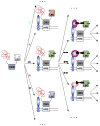Variable steroid receptor responses: Intrinsically disordered AF1 is the key
- PMID: 23792173
- PMCID: PMC3781172
- DOI: 10.1016/j.mce.2013.06.007
Variable steroid receptor responses: Intrinsically disordered AF1 is the key
Abstract
Steroid hormones, acting through their cognate receptor proteins, see widespread clinical applications due to their ability to alter the induction or repression of numerous genes. However, steroid usage is limited by the current inability to control off-target, or non-specific, side-effects. Recent results from three separate areas of research with glucocorticoid and other steroid receptors (cofactor-induced changes in receptor structure, the ability of ligands to alter remote regions of receptor structure, and how cofactor concentration affects both ligand potency and efficacy) indicate that a key element of receptor activity is the intrinsically disordered amino-terminal domain. These results are combined to construct a novel framework within which to logically pursue various approaches that could afford increased selectivity in steroid-based therapies.
Keywords: A(max) and EC(50); AF1 domain as a molecular rheostat; Intrinsically disordered domains; Selective receptor modulators (SRMs); Selectivity in controlling gene expression; Steroid receptors.
Published by Elsevier Ireland Ltd.
Figures

References
-
- Andersen RJ, Mawji NR, Wang J, Wang G, Haile S, Myung JK, Watt K, Tam T, Yang YC, Banuelos CA, Williams DE, McEwan IJ, Wang Y, Sadar MD. Regression of castrate-recurrent prostate cancer by a small-molecule inhibitor of the amino-terminus domain of the androgen receptor. Cancer Cell. 2010;17:535–546. - PubMed
Publication types
MeSH terms
Substances
Grants and funding
LinkOut - more resources
Full Text Sources
Other Literature Sources
Medical

